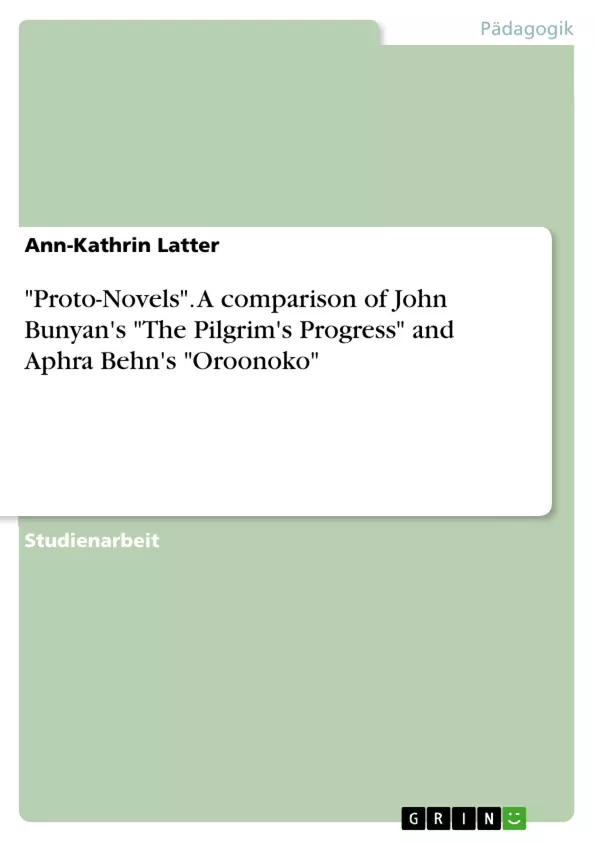The novel as a form of creation has never been a fixed medium. From the time of its first emergence onwards, it has always been in a state of continual change and oscillation. In the 17th century especially, when the early "novelists" made serious efforts to distinguish their writings from antecedent forms of literature, there were a large number of experiment[s] in the infancy of the novel, which brought new narrative possibilities in general and an enriched conceptualization of "the story" in particular.
This term paper seeks to explore the various elements that make proto-novels stand out from earlier types of writing. To read a novel and to recognize the narrative strategies within its word flow is to really understand what makes the text work. And since a comparison with other writings of its time and epoch can substantially increase the comprehension and appreciation of a given text, the two "proto-novels" of John Bunyan’s "The Pilgrim’s Progress" and Aphra Behn’s "Oroonoko" will are contrasted.
Inhaltsverzeichnis
- Introduction
- The basic elements of narrative situation and communicative frameworks
- The various types of narrators
- Narrative perspective and fundamental motifs
- Storytelling strategies
- A short overview of the analytical criteria used in this paper
- Narrative modes in John Bunyan's Pilgrim's Progress
- The narrator's relation to the portrayed happenings
- Discontinuities in the configuration of the narrative perspective
- Aphra Behn's Oroonoko as a precursor of the novel
- Oroonoko as a personalized narrative with the power of a focused report
- Objectivity and subjectivity in Oroonoko
Zielsetzung und Themenschwerpunkte
Die vorliegende Arbeit analysiert die narrativen Modi in John Bunyans "Pilgrim's Progress" und Aphra Behn's "Oroonoko" und untersucht, wie diese Werke als Vorläufer des Romans betrachtet werden können. Die Analyse konzentriert sich auf die Verwendung von Erzählperspektiven, -strategien und -strukturen, um die spezifischen Merkmale dieser frühen Romane zu beleuchten.
- Die Entstehung des Romans als literarische Gattung im 17. Jahrhundert
- Die Rolle der religiösen und sozialen Kontexte in der Entwicklung der frühen Romane
- Die Analyse der narrativen Modi in "Pilgrim's Progress" und "Oroonoko" im Hinblick auf Erzählperspektive, -strategie und -struktur
- Die Bedeutung dieser Werke als Vorläufer des modernen Romans
- Die Herausforderungen und Möglichkeiten der Verwendung von Allegorien und Metaphern in literarischen Texten
Zusammenfassung der Kapitel
- Die Einleitung legt den Grundstein für die Analyse der narrativen Modi in "Pilgrim's Progress" und "Oroonoko" und beleuchtet die Entwicklung des Romans als literarische Gattung im 17. Jahrhundert.
- Das zweite Kapitel erörtert die grundlegenden Elemente der Erzählsituation und der kommunikativen Rahmenbedingungen. Es analysiert verschiedene Arten von Erzählern, die narrativen Perspektiven und die wichtigsten erzählenden Motive sowie die Strategien, die in der Geschichte verwendet werden. Schließlich werden die analytischen Kriterien vorgestellt, die in dieser Arbeit verwendet werden.
- Das dritte Kapitel befasst sich mit den narrativen Modi in John Bunyans "Pilgrim's Progress". Es analysiert die Beziehung des Erzählers zu den dargestellten Ereignissen und die Diskontinuitäten in der Konfiguration der Erzählperspektive.
- Das vierte Kapitel untersucht Aphra Behn's "Oroonoko" als Vorläufer des Romans. Es beleuchtet, wie Oroonoko als eine personalisierte Erzählung mit der Kraft eines fokussierten Berichts fungiert und die Objektivität und Subjektivität in der Erzählung analysiert.
Schlüsselwörter
Die Arbeit konzentriert sich auf die narrative Entwicklung des Romans, insbesondere auf die Rolle von Erzählperspektive, -strategie und -struktur in frühen Romanen wie "Pilgrim's Progress" und "Oroonoko". Wichtige Themen sind die Verwendung von Allegorien und Metaphern, die Beziehung zwischen Autor und Leser sowie die Auswirkungen des historischen und sozialen Kontextes auf die Entstehung des Romans.
- Quote paper
- Ann-Kathrin Latter (Author), 2019, "Proto-Novels". A comparison of John Bunyan's "The Pilgrim's Progress" and Aphra Behn's "Oroonoko", Munich, GRIN Verlag, https://www.grin.com/document/490065



